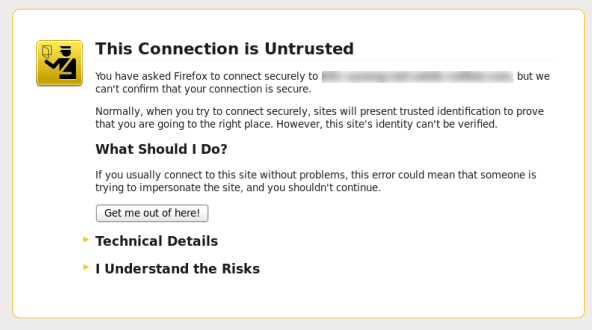Red Hat Training
A Red Hat training course is available for Red Hat Satellite
Chapter 1. Accessing Red Hat Satellite
1.1. Logging in to Red Hat Satellite
After Red Hat Satellite has been installed and configured, use the web user interface to log in to Satellite for further configuration.
Procedure 1.1. Installing the Katello Root CA Certificate
The first time that you log in to Satellite, it is possible that you will see a warning informing you that you are using the default self-signed certificate. It is possible that you will not be able to connect this browser to Satellite until the proper root CA certificate is installed in the browser. Use the following procedure to locate the root CA certificate on the Satellite server and to install it in your browser.
- Browse to
http://HOSTNAME/pub - Select katello-server-ca.crt.
- Import the certificate into your browser.
Procedure 1.2. To Log in to Satellite:
- Access the Satellite Server using a web browser pointed to the following address:
https://HOSTNAME/To identify your host name, use thehostnamecommand at the prompt:# hostname
Important
An untrusted connection warning appears on your web browser when accessing Satellite for the first time. Accept the self-signed certificate and add the Satellite URL as a security exception to override the settings. This procedure might differ depending on the browser being used.Only do this if you are sure that the Satellite URL is a trusted source.
Figure 1.1. Untrusted Connection Warning
- Enter the user name and password created during the configuration process. If a user was not created during the configuration process, the default user name is admin. If you have forgotten the password of the default administrative account, admin, see Section 1.2, “Changing the Password in Red Hat Satellite”.
Result
When you have successfully logged in, you are taken to the Satellite dashboard. The dashboard contains an overview of the Satellite and the hosts registered. For more information, see Using the Red Hat Satellite Content Dashboard and Searching and Bookmarking in the Red Hat Host Configuration Guide.
The main navigation tabs are as follows:
Table 1.1. Navigation Tabs
| Navigation Tabs | Description |
|---|---|
| Default Organization | Clicking this tab changes the organization and location. If no organization or location is selected, the default organization is Any Organization and the default location is Any Location. Use this tab to change to different values. |
| Monitor | Provides summary dashboards and reports. |
| Content | Provides content management tools. This includes Content Views, Activation Keys, and Life Cycle Environments. |
| Containers | Provides container management tools. |
| Hosts | Provides host inventory and provisioning configuration tools. |
| Configure | Provides general configuration tools and data including Host Groups and Puppet data. |
| Infrastructure | Provides tools on configuring how Satellite 6 interacts with the environment. |
| Red Hat Insights | Provides Red Hat Insights management tools. |
| Administer | Provides advanced configuration for settings such as Users and RBAC, as well as general settings. |
| User Name | Provides user administration where users can edit their personal information. |
Warning
Satellite Server will be listed as a host itself even if it is not self-registered. Do not delete the Satellite Server from the list of hosts.

